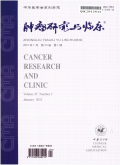基于Olink蛋白质组学建立鼻咽癌患者重度急性放疗不良反应预测模型
Establishment of a predictive model for severe acute radiotherapy adverse reactions in nasopharyngeal carcinoma patients based on Olink proteomics
摘要目的:探讨鼻咽癌患者放疗前血浆中炎性细胞因子水平与急性放疗不良反应的关系,初步建立放疗期间重度急性不良反应发生风险的预测模型。方法:横断面研究。回顾性选取2016年5月至2019年3月就诊于中国医学科学院肿瘤医院接受根治性放疗的85例鼻咽癌患者。按照美国肿瘤放疗协作组(RTOG)急性放射性损伤评价标准评估放疗期间放射性口腔黏膜炎、放射性皮炎和口干发生的最高等级不良反应,以其≥3级为重度。采用Olink蛋白质组学技术,检测患者首次放疗前血浆中92种炎性细胞因子水平(标准化的蛋白表达值)。采用单因素方差分析和独立样本 t检验分析炎性细胞因子与临床因素及与放疗期间3种急性不良反应的关系。基于炎性细胞因子和(或)临床因素,采用二元logistic回归构建重度急性放疗不良反应发生风险的预测模型。以美国RTOG急性放射性损伤评价标准评定的放疗期间最严重等级的不良反应是否重度为金标准,采用受试者工作特征(ROC)曲线分析依据构建的各模型判断重度急性放疗不良反应发生的效能。 结果:85例患者中,男性68例,女性17例;中位年龄[ M( Q1, Q3)]49岁(43岁,60岁);所有患者均接受根治性放疗,其中64例联合化疗或靶向治疗。19例(22.1%)出现重度急性放疗不良反应。1、2、3级急性放射性口腔黏膜炎患者放疗前血浆白细胞介素22受体A1(IL-22RA1)、白细胞介素18受体1(IL-18R1)、嗜酸性粒细胞趋化因子(CCL11)、肿瘤坏死因子超家族成员14(TNFSF14)、酪氨酸激酶受体3配体(Flt3L)和单核细胞趋化蛋白2(MCP-2)水平差异均有统计学意义(均 P<0.05);1、2、3级急性放射性皮炎患者放疗前血浆CD244、CC趋化因子配体20(CCL20)、白血病抑制因子受体(LIF-R)和白细胞介素(IL)-4水平差异均有统计学意义(均 P<0.05);1级和2级口干患者放疗前血浆IL-12B、CXC型趋化因子配体11(CXCL11)、LIF-R和IL-33水平差异均有统计学意义(均 P<0.05)。单因素方差分析中,各临床因素与严重急性放疗不良反应均不相关(均 P>0.05),根据文献选取年龄、T分期、N分期、临床分期、是否接受化疗、是否患有糖尿病6个临床因素建立二元logistic回归模型M1。根据细胞因子功能和既往文献,在差异细胞因子中选取IL-22RA1、IL-18R1、MCP-2、CCL11、CD244、CCL20和IL-33建立二元logistic回归模型M2。结合上述临床因素和细胞因子建立二元logistic回归模型M3。ROC曲线分析显示,预测模型M1、M2和M3判断重度急性放疗不良反应发生的曲线下面积分别为0.787、0.841、0.868。 结论:不同等级急性放疗不良反应鼻咽癌患者间放疗前血浆中多种炎性细胞因子表达水平有差异,基于患者首次放疗前血浆炎性细胞因子水平结合临床因素构建模型能较好地预测重度急性放疗不良反应发生风险。
更多相关知识
abstractsObjective:To investigate the relationship between the inflammatory cytokines level in the plasma of nasopharyngeal carcinoma patients before radiotherapy and acute radiotherapy adverse reactions, and to establish a preliminary model for predicting the risk of severe acute adverse reactions during radiotherapy.Methods:A cross-sectional study was conducted. A total of 85 nasopharyngeal carcinoma patients who received radical radiotherapy in Cancer Hospital of Chinese Academy of Medical Sciences from May 2016 to March 2019 were retrospectively collected. The highest grade adverse reactions of radiation oral mucositis, radiation dermatitis and xerostomia during radiotherapy were evaluated according to the American Cancer Radiotherapy Collaboration (RTOG) acute radiation injury evaluation criteria, and the above adverse reactions ≥ grade 3 were treated as the severity. Olink proteomics technology was used to detect the level of 92 inflammatory cytokines (the standardized protein expression values) in the plasma of patients before radiotherapy for the first time. Single factor analysis of variance and independent sample t-test were used to analyze the relationship between inflammatory cytokines and clinical factors, as well as acute adverse reactions during radiotherapy. Based on inflammatory cytokines and/or the clinical factors, binary logistic regression was used to construct a predictive model for the risk of severe acute radiotherapy adverse reactions. Whether the most severe adverse reactions assessed by the American RTOG acute radiation injury evaluation criteria during radiotherapy were severe or not were taken as the gold standard. Receiver operating characteristic (ROC) curve was used to analyze the effectiveness of the established models for judging the severe acute adverse reactions. Results:Among the 85 patients, 68 were males and 17 were females, with the median age [ M ( Q1, Q3)] of 49 years (43 years, 60 years). All patients received radical radiotherapy, of which 64 cases were treated with combination chemotherapy or targeted therapy. A total of 19 cases (22.1%) experienced severe acute radiotherapy adverse reactions. There were statistically significant differences in the levels of interleukin (IL)-22 receptor A1 (IL-22RA1), IL-18 receptor 1(IL-18R1), eotaxin-1 (CCL11), tumor necrosis factor ligand superfamily member 14 (TNFSF14), FMS-like tyrosine kinase 3 ligand (Flt3L), and monocyte chemotactic protein 2 (MCP-2) in the plasma of patients with grade 1, 2, 3 acute radiation oral mucositis before radiotherapy; there were statistically significant differences in the levels of CD244 (all P < 0.05); there were statistically significant differences in the levels of CD244, CC chemokines ligand 20 (CCL20), leukemia inhibitory factor ligand (LIF-R) and IL-4 in the plasma of patients with grade 1, 2, 3 acute radiation dermatitis before radiotherapy (all P < 0.05); there were statistically significant differences in the levels of IL-12B, CXC chemokines ligand 11 (CCL11), LIF-R and IL-33 in the plasma between patients with grade 1 and grade 2 xerostomia before radiotherapy (all P<0.05). The result of single factor analysis of variance showed that the clinical factors were not associated with severe acute radiation adverse reactions (all P > 0.05). Binary logistic regression model M1 was established by selecting 6 clinical factors including age, T staging, N staging, clinical staging, whether to receive chemotherapy or not and whether to suffer from diabetes or not in the literatures. Based on cytokine function and previous literatures, the binary logistic regression model M2 was established by selecting IL-22RA1, IL-18R1, MCP-2, CCL11, CD244, CCL20 and IL-33 from the differential cytokines. A binary logistic regression model M3 was established by combining the above clinical factors with cytokines. The ROC curve analysis showed that the area under the curve of the M1, M2, M3 predictive models for judging the severe acute radiation adverse reactions was 0.781, 0.841, 0.868, respectively. Conclusions:There were differences in the expression levels of various inflammatory cytokines in plasma before radiotherapy among patients with different grades of acute radiotherapy adverse reactions. Building the models based on plasma inflammatory cytokine levels combined with clinical factors before the first radiotherapy could effectively predict the risk of severe acute radiotherapy adverse reactions in patients with nasopharyngeal carcinoma.
More相关知识
- 浏览0
- 被引0
- 下载0


相似文献
- 中文期刊
- 外文期刊
- 学位论文
- 会议论文



 换一批
换一批 换一批
换一批



